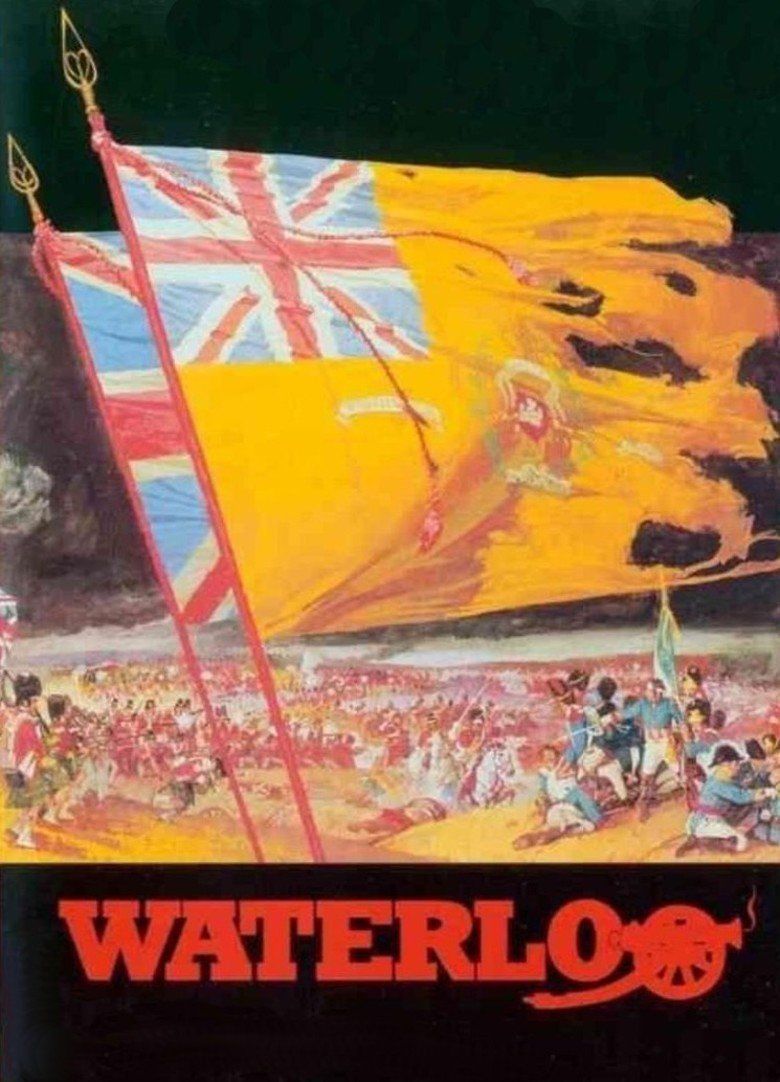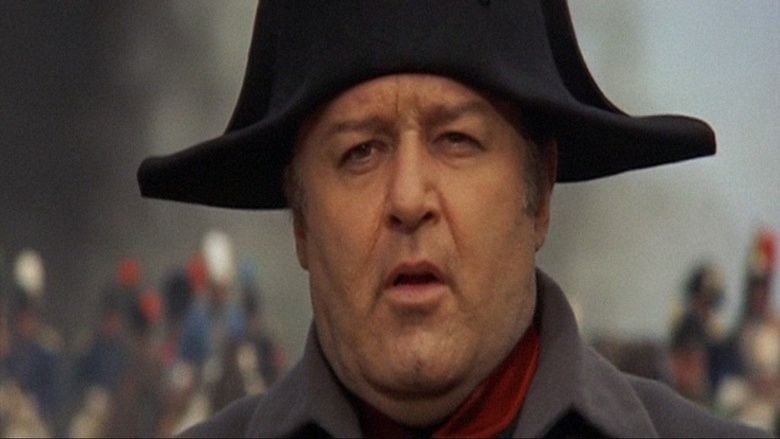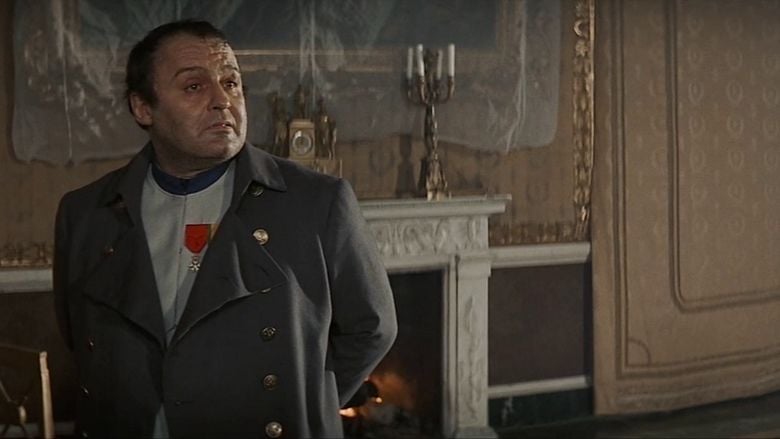Waterloo (1970 film)
7.2 /10 1 Votes
Duration Language RussianEnglish | 7.2/10 IMDb Genre Action, Drama, History Country ItalySoviet Union | |||||||||||||||||||||||||||||||||
 | ||||||||||||||||||||||||||||||||||
Release date 1970 (1970) Writer H.A.L. Craig (story), Sergey Bondarchuk (screenplay), Vittorio Bonicelli (screenplay), Mario Soldati (dialogue: Italian version) Cast (Napoleon Bonaparte), (Arthur Wellesley, Duke of Wellington), (Louis XVIII), (General Sir Thomas Picton), (Duchess of Richmond), (Marshal Michel Ney) Similar movies The Iron Duke (1934), Sharpes Waterloo (1997), Lines of Wellington (2012), The Duellists (1977), Jack Hawkins appears in Waterloo and Zulu | ||||||||||||||||||||||||||||||||||
Waterloo 1970 full movie part 12
Waterloo (Russian: Ватерлоо) is a 1970 epic period war film directed by Sergei Bondarchuk and produced by Dino De Laurentiis. It depicts the story of the preliminary events and the Battle of Waterloo and is famous for its lavish battle scenes.
Contents
- Waterloo 1970 full movie part 12
- Waterloo 1970 full movie part 9
- Plot
- Production
- Historical inaccuracies
- Reception
- References

It stars Rod Steiger as Napoleon Bonaparte and Christopher Plummer as the Duke of Wellington with a cameo by Orson Welles as Louis XVIII of France. Other stars include Jack Hawkins as General Thomas Picton, Virginia McKenna as the Duchess of Richmond and Dan O'Herlihy as Marshal Ney.

Waterloo 1970 full movie part 9
Plot

In 1814 French Emperor Napoleon Bonaparte, facing certain defeat at the hands of Britain, Austria, Prussia and Russia (the Sixth coalition), abdicates at the demand of his marshals. He is banished to Elba with 1,000 men, but escapes and returns to France. Ney, now serving the monarchy of Louis XVIII of France, is tasked with recapturing him, but he and his army defect to Napoleon. King Louis flees, Napoleon triumphantly enters Paris, and the European powers declare war.

The Prussian von Muffling interrupts the Duchess of Richmond's ball to warn the Duke of Wellington that Napoleon has invaded Belgium to defeat the Allied forces before they can unite. Realising that Napoleon has got between himself and the Prussians, Wellington decides to halt the French at Waterloo.

The French fight the British to a draw at Quatre-Bras, but defeat the Prussians at Ligny. Field Marshal Blücher rejects the advice of his Chief of Staff, General Gneisenau to retreat and instead moves north to Wavre to keep contact with Wellington. Napoleon, enraged that Ney has let Wellington withdraw to ground of his choosing, directs 30,000 men under Marshal Grouchy to pursue Blücher and keep the Prussians from rejoining the British, while he leads his remaining force against Wellington.
The battle of Waterloo, delayed to let the ground dry after the previous night's storm, starts shortly after 11:30 am with cannon fire from the French. Napoleon launches a diversionary infantry attack on Wellington's right flank, the Chateau of Hougoumont, but Wellington refuses to divert forces. Napoleon then attacks the allied left with d'Erlon's infantry corps. General Picton successfully halts the attack but is killed. Ponsonby's cavalry brigade, the renowned Royal Scots Greys, pursue the French, but go too far across the battlefield and become isolated from the rest of the Allied force, and are thus cut to pieces by Napoleon's lancers. Ponsonby himself is killed.
Napoleon realises that troops spotted emerging from the woods to the east are Prussians (Blücher's army), not French (Grouchy's force), but keeps this from his army. He then suffers stomach pain and withdraws temporarily, leaving Marshal Ney in command. Ney misinterprets a reorganisation of the Allied line as a retreat and leads a cavalry charge, which is repelled with heavy losses by allied infantry squares.
Napoleon returns and rebukes his marshals for letting Ney attack without infantry support. However he hopes that Wellington's line has been worn down. The British farmhouse of La Haye Sainte falls, and Napoleon sends the Imperial Guard for the decisive blow. As they advance they are repulsed by Maitland's Guards Division, who were lying unseen in the grass on the reverse of the slope. The repulse of the Guard devastates French morale, and the arrival of the Prussians makes matters certain. After refusing to surrender, the Imperial Guard squares are annihilated with close range artillery.
After the battle, Wellington wanders among the piles of dead, lamenting the cost of victory. At the same time Napoleon, who had declared that he would die with his men, is dragged by his marshals from the field and later departs in a carriage for Paris.
Production
Columbia Pictures published a 28-page, full-colour pictorial guide when it released Waterloo in 1970. According to the guidebook, Italian producer Dino De Laurentiis had difficulty finding financial backers for the massive undertaking until he finally began talks with the Soviets in the late 1960s and reached agreement with the Mosfilm organization. Final costs were over £12 million (UK) (equivalent to about US $38.3 million in 1970), making Waterloo, for its time, one of the most expensive movies ever made. Had the movie been filmed in the West, costs might have been as much as three times this. Mosfilm contributed more than £4 million of the costs, nearly 17,000 soldiers of the Soviet Army, including a full brigade of Soviet cavalry, and a host of engineers and labourers to prepare the battlefield in the rolling farmland outside Uzhhorod, Ukraine (then part of the Soviet Union).
To recreate the battlefield authentically, the Soviets bulldozed away two hills, laid five miles of roads, transplanted 5,000 trees, sowed fields of rye, barley and wildflowers and reconstructed four historic buildings. To create the mud, more than six miles of underground irrigation piping was specially laid. Most of the battle scenes were filmed using five Panavision cameras simultaneously—from ground level, from 100 foot towers, from a helicopter, and from an overhead railway built right across the location.
Actual filming was accomplished over 28 weeks, which included 16 days of delay (principally due to bad weather). Many of the battle scenes were filmed in the summer of 1969 in often sweltering heat. In addition to the battlefield in Ukraine, filming also took place on location in Caserta, Italy, while interior scenes were filmed on the large De Laurentiis Studios lot in Rome. A massive quantity of The film includes about 15,000 Soviet foot soldiers and 2,000 cavalrymen as extras and 50 circus stunt riders were used to perform the dangerous horse falls. It has been joked that Sergei Bondarchuk was in command of the seventh-largest army in the world. Months before the cameras started filming, the 17,000 soldiers began training to learn 1815 drill and battle formations, as well as the use of sabres, bayonets and handling cannon. A selected 2,000 additional men were also taught to load and fire muskets. This army lived in a large encampment next to the battlefield. Each day after breakfast, they marched to a large wardrobe building, donned their French, British or Prussian uniforms and fifteen minutes later were in position. The soldiers were commanded by officers who took orders from director Sergei Bondarchuk by walkie-talkie. To assist in the direction of this huge, multi-national undertaking, the Soviet-Ukrainian director had four interpreters permanently at his side: one each for English, Italian, French and Serbo-Croatian.
Historical inaccuracies
While the film portrayed the events of the "Hundred Days" quite faithfully, including some allusions to and scenes from the Battle of Ligny and of Quatre Bras, there were a few mistakes, presumably made for artistic purposes, and some characters act as ciphers for others. In the opening scene, where the marshals are attempting to persuade Napoleon to abdicate, Marshal Soult is present: in 1814, Soult was commanding the defence of Toulouse against Wellington's Army.
At the Duchess of Richmond's ball (which itself was held in something more like a barn than the magnificent ballroom depicted ), there is an entirely fictional romantic sub-plot with Lord Hay and one of the Duchess' daughters.
Unlike the Prussians in the movie, arriving at the right flank of the French force, General Bülow's 4th corps attacked at the rear-right of the French lines at the village of Plancenoit. Napoleon sent first his reserve corps (under General Lobau) and then the Second Foot Grenadiers, the second-most-senior corps of his Imperial Guard, to engage and delay these Prussians while maintaining his front line; these clashes in and around the village of Plancenoit were crucial to the battle; around 7:30 PM, another Prussian corps under Marshal Blücher arrived on the battlefield to link with the British army on the grounds of the inn La Belle Alliance, sealing the fate of the French force.
William Ponsonby, before leading the British cavalry charge, tells the Earl of Uxbridge that Ponsonby's father had been killed in battle by lancers, not least because he had been riding an inferior horse: in fact his father had been a politician who died of natural causes back in England, and he is simply foretelling his own fate in the battle.
The Duke of Gordon is depicted as leading his Gordon Highlanders into battle, and is described by the Duchess of Richmond as "uncle": in fact, he is a conflate character, representing the contributions of several members of the House of Gordon. The Duke at the time, the founder and colonel of the regiment, was the Duchess of Richmond's father, and he saw no active service overseas during the Napoleonic Wars; his son and the Duchess's brother, the Marquis of Huntly (later the 5th Duke) was a distinguished general, but held no command in the campaign, although anecdotal evidence suggests that he arrived during the aftermath of the battle; the senior representative of the family at the battle was in fact the Duchess's own twenty-three-year-old son, the Earl of March, who would eventually become the 5th Duke's heir in 1836, and who served as a major and an aide de camp to the Duke of Wellington; another branch of the family was represented by another ADC, Colonel Sir Alexander Gordon, aged twenty-eight or twenty-nine, the brother of the Earl of Aberdeen; in reality, both were young men similar in age and duty to Lord Hay. The field commander of the Gordon regiment during the campaign, Lieutenant Colonel, John Cameron of Fassiefern, had been killed at the battle of Quatre Bras on 16 June. The acting commander of the regiment during the battle appears to have been Major Donald MacDonald of Dalchosnie.
The story of the refusal of the guard to surrender is false as historically not only did the guard surrender, but Pierre Cambronne, the man portrayed as saying "merde", denied ever having said this, nor did he die in battle.
Reception
The film was the fifth most popular "reserve ticket" movie at the British box office in 1971. However, it failed to recoup its cost. Post release saw the film gain popularity and receive numerous positive reviews for its battle depiction. The film is rumoured to have originally been 4 hours long as shown in the Soviet Union. Several historical characters listed in the credits do not actually appear in the film, they are said to have been in scenes cut before release. In this "extended version", the chronology of Waterloo is said to have been much more detailed, as well as more in depth coverage of the Battle of Ligny.
The film won two BAFTA awards in 1971 (Best art direction and best costume design) and was nominated for a third (best cinematography). The film was also novelized by Frederick E. Smith, with the content based on the screenplay.
References
Waterloo (1970 film) WikipediaWaterloo (1970 film) IMDb Waterloo (1970 film) themoviedb.org
